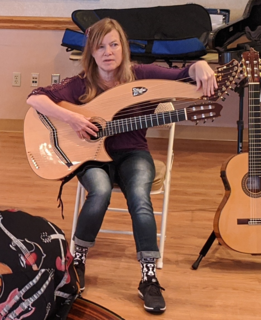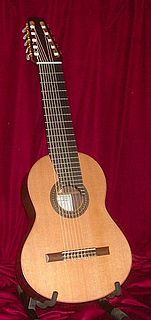Related Research Articles

The classical guitar is a member of the guitar family used in classical music. An acoustic wooden string instrument with strings made of gut or nylon, it is a precursor of the modern acoustic and electric guitars, both of which use metal strings. Classical guitars are derived from the Spanish vihuela and gittern in the fifteenth and sixteenth century, which later evolved into the seventeenth and eighteenth-century Baroque guitar and later the modern classical guitar in the mid-nineteenth century.

The harp is a stringed musical instrument that has a number of individual strings running at an angle to its soundboard; the strings are plucked with the fingers. Harps can be made and played in various ways, including standing or sitting and in orchestras or concerts. Its most common form is triangular in shape and made of wood. Some have multiple rows of strings and pedal attachments.

A lute is any plucked string instrument with a neck and a deep round back enclosing a hollow cavity, usually with a sound hole or opening in the body. It may be either fretted or unfretted.

Andrés Segovia Torres, 1st Marquis of Salobreña was a virtuoso Spanish classical guitarist from Linares, Spain. Many professional classical guitarists today were students of Segovia, or students of his students. Segovia's contribution to the modern-romantic repertoire not only included commissions but also his own transcriptions of classical or baroque works. He is remembered for his expressive performances: his wide palette of tone, and his distinctive musical personality, phrasing and style.

Fernando Sor was a Spanish classical guitarist and composer. Best known for writing solo classical guitar music, he also composed an opera, three symphonies, guitar duos, piano music, songs, a Mass, and at least two successful ballets: Cinderella, which received over one hundred performances, and Hercule et Omphale.

A guitar solo is a melodic passage, instrumental section, or entire piece of music written for a classical guitar, electric guitar or an acoustic guitar. In 20th and 21st century traditional music and popular music such as blues, swing, jazz, jazz fusion, rock and metal, guitar solos often contain virtuoso techniques and varying degrees of improvisation. Guitar solos on classical guitar, which are typically written in musical notation, are also used in classical music forms such as chamber music and concertos.

Fingerstyle guitar is the technique of playing the guitar or bass guitar by plucking the strings directly with the fingertips, fingernails, or picks attached to fingers, as opposed to flatpicking. The term "fingerstyle" is something of a misnomer, since it is present in several different genres and styles of music—but mostly, because it involves a completely different technique, not just a "style" of playing, especially for the guitarist's picking/plucking hand. The term is often used synonymously with fingerpicking except in classical guitar circles, although fingerpicking can also refer to a specific tradition of folk, blues and country guitar playing in the US. The terms "fingerstyle" and "fingerpicking" also applied to similar string instruments such as the banjo.

The harp guitar is a guitar-based stringed instrument generally defined as a "guitar, in any of its accepted forms, with any number of additional unstopped strings that can accommodate individual plucking." The word "harp" is used in reference to its harp-like unstopped open strings. A harp guitar must have at least one unfretted string lying off the main fretboard, typically played as an open string.
William Coulter is an American Celtic guitarist, performer, recording artist, and teacher. Since 1981 he has explored the world of traditional music as a soloist with ensembles including Isle of Skye, Orison, and the Coulter-Phillips Ensemble.

The early romantic guitar, the guitar of the Classical and Romantic period, shows remarkable consistency from 1790 to 1830. Guitars had six or more single courses of strings while the Baroque guitar usually had five double courses. The romantic guitar eventually led to Antonio de Torres Jurado's fan-braced Spanish guitars, the immediate precursors of the modern classical guitar.

Muriel Anderson is an American fingerstyle guitarist and harp guitarist who plays in many genres. She is the first woman to win the National Fingerpicking Guitar Championship.
Andrei Krylov is a Russian guitarist, 7- and 6- string classical guitar, composer and poet. He studied classical guitar, arrangement and composition in Saint Petersburg and later emigrated to Canada. In the 1980s and 1990s he worked as a guitarist for the Russian State concert company Lenconcert and the Old Petersburg music theater. He has given recitals in Russia, Ukraine, Estonia, USA and Canada. Krylov has recorded and performed for Russian, US and Canadian radio and television. He has composed original new flamenco and new-age music for films in Russia and the USA. His music has been featured in Time magazine. The National Gallery of Canada has placed six films with Krylov's music in its Media Library. He also composed and recorded guitar music for films in Europe, New Zealand, Australia and USA including music for film about Esteban Vicente for museums featuring his art in New York and Madrid and the 2011 short film Katya by Mako Kamitsuna, featuring Tatar-Russian movie star Chulpan Khamatova. Krylov's classical/romantic guitar music was #1 in 2005 at Download.com website music charts [3]Download.com website.

The ten string extended-range classical guitar, with fully chromatic, sympathetic string resonance was conceived in 1963 by Narciso Yepes, and constructed by José Ramírez [III]. This instrument is sometimes referred to as the "modern" 10-string guitar to differentiate it from ten-stringed harp guitars of the 19th century.

The eleven-string alto guitar is an extended-range classical guitar developed by Swedish luthier Georg Bolin in the 1960s.
Randal Bays is a fiddler, guitarist and composer. The American-born Irish-style fiddle and guitar player first gained international recognition through his recordings and performances with Co. Clare fiddler Martin Hayes in the early 1990s. He began playing music at the age of eight and was widely known as a fiddler in the U.S. long before recording with Hayes as guitar accompanist. Born in Indiana in 1950, Bays relocated to the Pacific Northwest as a teenager and has made his home in Oregon and Washington since then. His musical life included serious study of the classical guitar, prior to taking up Irish fiddling in the 1970s. At the time, he lived in Portland, Oregon, and was strongly influenced by Co. Cavan accordion player Michael Beglan, also fiddler Kevin Burke and guitarist Mícheál Ó Domhnaill.

Ricardo Jesús Gallén García, is a Spanish classical guitarist who has been active since the mid-1990s. He is currently a professor of guitar at the Hochschule für Musik Franz Liszt, Weimar, Germany.

To a greater extent than most other instruments and ensembles, it is difficult to compose music for the guitar without either proficiency in the instrument or close collaboration with a guitarist. As a result, a large part of the guitar repertoire consists of works by guitarists who did not compose extensively for other instruments. Music prior to the classical era was often composed for performance on various combinations of instruments, and could be adapted by the performer to keyboard instruments, the lute, or the guitar. Since the beginning of the 20th century, however, a significant amount of music has been written for the guitar by non-guitarist composers.
Peter Croton is a Swiss-American lutenist and guitarist. He has attained prominence in his field through his numerous recordings, performances, publications, and teaching engagements. His recorded repertoire includes music from the Renaissance, Baroque and Classical periods, as well as his own compositions. His publications include a figured bass manual for classical guitarists and publications of compositions for voice and lute.

Héctor Antonio García Hernandez is a Cuban-American classical guitarist and composer. He established the first guitar departments in United States universities, at the College of St. Joseph on the Rio Grande in 1963 and the University of New Mexico at Albuquerque in 1967, where he taught for about 20 years.
Njål Vindenes is a Norwegian classical musician residing in Bergen, Norway.